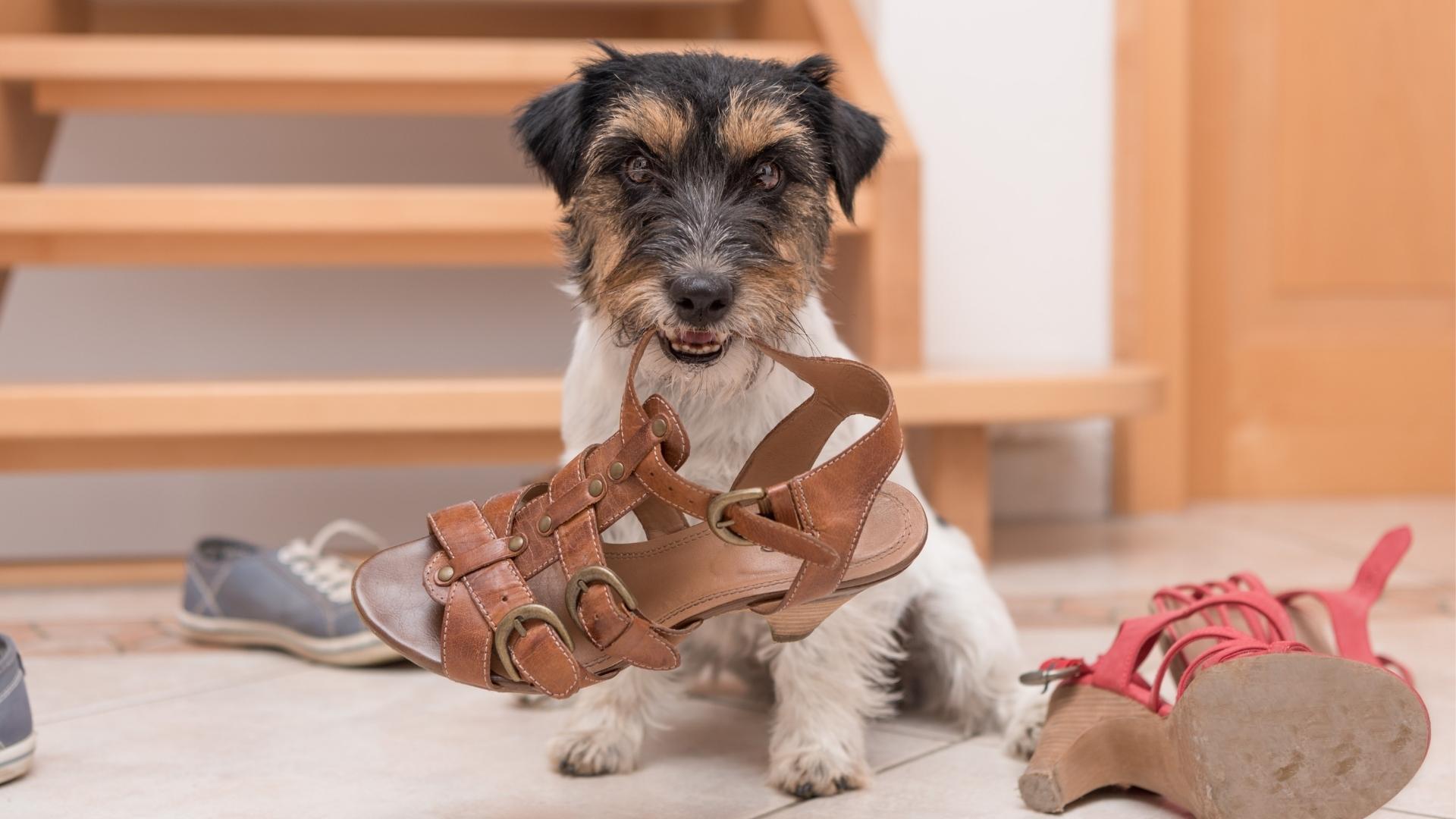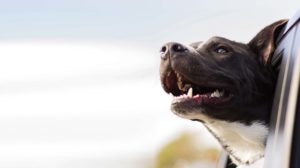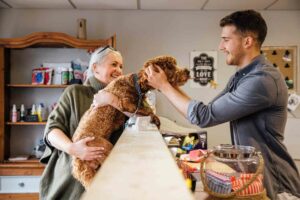Whether you are welcoming a young puppy or an adult dog into your family, being prepared and well informed is important. A few ways to manage behaviours like chewing is by:
- Prevention and management
- Interruption
- Teaching and reinforcing
Prevention and management is about managing your dog’s environment by removing any items that you don’t want your pet to chew, setting up a puppy pen or a suitable room, and ensuring the dog’s needs are being physically and mentally met (this is to help keep you both happy!).
Interrupting the behaviour is giving the dog a more suitable thing to do which discontinues the dog from practicing the undesirable behaviour. This could be playing a game, bringing their attention back to you, giving something more appropriate to chew or engaging in training. Interruption only works if someone is present as the behaviour is about to happen.
Teaching and reinforcement is about educating your dog and putting them in an environment and situation to learn the appropriate and desirable way to behave. By frequently reinforcing the correct behaviours, we are making them [behaviours] more valuable to the dog and therefore are more likely to be repeated.
Bringing a new puppy home
First let’s address the big question – why do dogs bite and chew? Dogs explore the world with their nose and mouth by investigating new tastes, textures, and smells. They also use their mouths to initiate play and interaction, express frustration and soothe sore gums. It is absolutely normal and reasonable for a puppy to exhibit these behaviours, and they should not be punished for it. Rather, think about how you can help with your pup’s physical and mental needs to help redirect them to more appropriate items which they can chew on instead.
You can begin to implement rules and boundaries from day one in order to set your little one up for a successful and happy life within your family. Note, it is unreasonable to expect a puppy not to ever get a hold of inappropriate things. Training your pup to learn what is and isn’t okay is a process and will take time. Your consistency and patience will aid in this process tremendously. Having a designated and secure area such as a puppy pen is a fantastic way to assist with prevention. When you are not directly interacting with your puppy, they should be in this area to prevent access to other rooms, items, furniture.
This space should include:
- Fencing, crate and bedding (new to crate training? Learn more here)
- Water bowl with plenty of fresh water
- Puppy appropriate chew toys can be found in reputable pet supply stores. Toy feeders are fantastic ways to feed your dog their meals as it keeps them occupied for longer periods without your involvement. This also helps build their confidence. Avoid soft stuffed toys or toys with squeakers as they can be torn, and pieces swallowed
- Avoid toys that send mixed messages; old shoes or toys that look like shoes, old clothes
- Floor protective covering (to protect your floor from scratches and any toileting accidents)
- A grass pet toilet if unable to access an appropriate outdoor area frequently (learn about toilet training here)
There are a few more items that can help your puppy learn what is or isn’t appropriate to put their mouth on:
- A long, light-weight rope or fleece toy to have on hand (not in their pen) to animate on the ground to deter pup from jumping and pull their attention away from clothes, skin, and shoes. You can also use this toy to interact and play with your pup from the other side of their pen
- Small pieces of healthy treats to reward appropriate play and training
- Lead or long line to be able to play and interact with your pup outside of their pen ensuring they stay close so you can manage the situation easily
Teaching your dog to voluntarily let go (any age)
The most appropriate and risk-free way to get something back from your dog (at any age) is to teach them to spit it out. This process applies to toys, shoes, clothes, sticks, rocks. Here’s how to teach “give”:
- First – find out what is more rewarding to your dog than the item – perhaps a yummy treat or another more enticing toy. For ease, we can call this the ‘reward’
- Sit down with your dog, a toy, and your reward
- Give a cue which indicates they can have access to the toy such as “yes” or “take” then animate the toy encouraging them to take a hold of it
- In your other hand, have your reward ready. If using food, keep the pieces small to help avoid over-feeding
- Hold the toy still, say “give” and present your other hand with the reward
- As your dog lets go of the toy to get the reward, mark this moment with “good” and give them the reward
- Repeat this process every single time making it fun and rewarding for your dog to give things up easily
- Do not request this behaviour from your dog if you are not in a position to give them something desirable in exchange for giving you what you want, especially in the beginning whilst they are still learning what the word means
- Once your dog spits the toy out in anticipation of reward once the “give” cue is given, this means they are learning the meaning of the word. Repeat more to solidify the behaviour
- If your pup has a hold of an inappropriate item, follow the same process and be sure to reward them for spitting it out and redirect them to something more appropriate. Following this, assess and manage the environment to prevent further inappropriate behaviour
- Do not ever stick your hand or fingers in a dog’s mouth as this can result in injury and breeding new problematic behaviours such as resource guarding. Additionally, do not chase them around the house as this could turn into a fun game or build fear into your dog
If the chewing becomes destructive and is causing harm to your dog, immediately contact your Veterinarian for advice as there could be underlying medical issues. Making sure to play, train and spend productive quality time with your pup or dog will help fade out undesirable behaviours.
The author of this article has been updated. Dr Claire Sharp was attributed as the author, and we unreservedly apologise to her and to the author for crediting her as the author of the article.
Pet insurance can help by covering a portion of the eligible vet bill if the unexpected happens. Because it is difficult to predict the costs of veterinary care, it can help to have measures in place to help prepare for the unexpected. Check out our partner network and explore our policy tools to find a pet insurance policy.
Not all conditions or items are covered by Pet Insurance. Refer to the applicable Product Disclosure Statement for information about coverage and exclusions.








